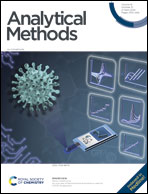Anti-aggregation colorimetric sensing of cysteine using silver nanoparticles in the presence of Pb2+
Abstract
Using silver nitrate as the silver source and sodium borohydride as the reducing agent, we synthesized negatively charged silver nanoparticles (AgNPs). Subsequently, the AgNPs solution was mixed with positively charged lead ions, resulting in AgNPs aggregation via electrostatic interactions. This led to a color change in the solution from yellow to purple and eventually to blue-green. Our study focused on a colorimetric method that exhibited high selectivity and sensitivity in detecting cysteine using AgNPs-Pb2+ as a sensing probe. Upon the introduction of cysteine to the AgNPs-Pb2+ system, the absorbance of AgNPs increased at 396 nm and decreased at 520 nm. The formation of a complex between cysteine and lead ions prevented the aggregation of silver nanoparticles, enabling the colorimetric detection of cysteine. The relationship between the concentration of ΔA396/A520 and cysteine showed linearity within the range of 0.01 to 0.1 μM; the regression equation of the calibration curve is ΔA396/A520 = 9.0005c − 0.0557 (c: μM), with an R2 value of 0.9997. The detection limit was found to be 3.8 nM (S/N = 3). This method demonstrated exceptional selectivity and sensitivity for cysteine and was effectively used for the determination of cysteine in urine. Our findings offer a new perspective for the future advancement of anti-aggregation silver nanocolorimetry.



 Please wait while we load your content...
Please wait while we load your content...